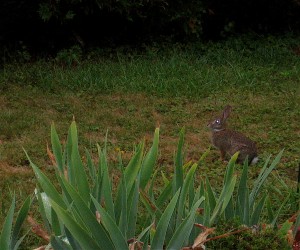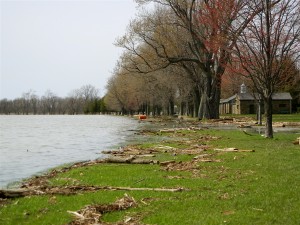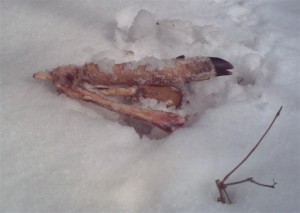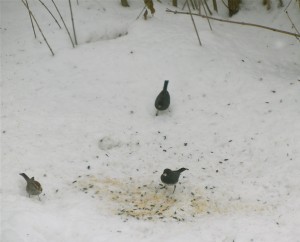Aug 19 2011
Year of the Rabbit
 They appear when least expected: late at night as I’m getting home from work; early in the morning when I’m retrieving the newspaper; sometimes in broad daylight, just sitting there in the middle of the yard. There have been rabbits in our neighborhood for as long as I can remember, but never have they been so ubiquitous. They are everywhere now, and in great abundance.
They appear when least expected: late at night as I’m getting home from work; early in the morning when I’m retrieving the newspaper; sometimes in broad daylight, just sitting there in the middle of the yard. There have been rabbits in our neighborhood for as long as I can remember, but never have they been so ubiquitous. They are everywhere now, and in great abundance.
I told my granddaughter, Maddie, that she would probably see rabbits when she, her cousins, and her brothers came to visit Judy and me last week, and sure enough she did. They all did. We flushed one from the day lilies during the first hour of play. My dog, Matika chased another one to the backyard fence late that afternoon. Maddie chased another shortly thereafter. On the last day, we saw a rabbit sitting in someone’s yard just as we were finishing a hike up Aldis Hill. They’re all over town it seems – not just in our neighborhood. Why the sudden influx?
Rabbits are closely associated with the idea of proliferation. “Breeding like rabbits,” someone says, and a horde of cute, furry creatures comes to mind. Then we smile. Even in great numbers they are non-threatening – our vegetable gardens notwithstanding. Come on now. If there was a movie about rabbits taking over the world, could it be anything but a comedy?
When tough guys talk about the “survival of the fittest,” they think of themselves as predators not prey. They identify with those fierce, toothy creatures at the very top of the food chain. But there are other survival strategies that work just as well, if not better. Proliferation is one of them. The hungry trout gobble up the mayflies as they hatch, but the mayflies survive anyway. There are simply too many of them. Clearly rabbits “survive” the same way. Breeding is the key to their success.
When I read Darwin’s The Origin of Species a few years back, I was surprised by the amount of sex talk in it. We commonly think of Darwinism as a tooth-and-claw worldview, but it has more to do with reproduction really. And rabbits, well, they do that quite well.
Fecundity. That’s one of my favorite words. I use it all the time when talking about wild nature. Top predators might get all the media attention, but it’s the breeders that dominate the planet. Most biomass consists of insects, vegetation and bacteria – all very fecund life forms. In the animal world, frogs, rodents and certain species of birds proliferate . . . along with rabbits. Yeah, rabbits. Bugs Bunny was no dummy. And the predators never did get the best of him.
Comments Off on Year of the Rabbit




